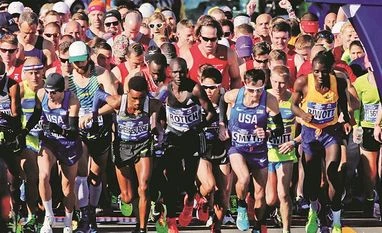The shoes came in the colours of a tropical drink, lime and orange and pink, as if the logo ought to be an umbrella instead of a Nike swoosh. You half expected the insoles to smell of rum and coconut.
If the colour scheme suggested frivolity, race results did not. The shoes cushioned the feet of all three medalists in the men’s marathon at the Rio Olympics last summer. Later, in the fall, they were worn by the winners of major marathons in Berlin, Chicago and New York. The latest shoe designs have produced fast times and impressive results in international races. But they have also spurred yet another debate about the advance of technology and the gray area where innovation meets extremely vague rules about what is considered unfair performance enhancement for the feet.
Where to draw the line of permissible assistance?
Many sports have struggled with the answer. Swimming allowed record-setting, full-body suits, then banned them after the 2008 Beijing Olympics because they gave an unfair advantage in buoyancy and speed. And track and field wrestled with the issue of prosthetic blades worn by the South African sprinter Oscar Pistorius.
The latest issue is shoes. Track’s governing body, the International Association of Athletics Federations, said in an email that it had received a number of inquiries about elite runners’ wearing new designs made by various companies. Its technical committee will meet within two weeks to “see if we need to change or review approvals.”
Bret Schoolmeester, Nike’s senior director for global running footwear, said, “We’re very confident we’re doing things within the rules and above board.”
On Tuesday, Nike unveiled a new shoe, a customised version of the one worn by the marathon winners in Rio de Janeiro and other recent high-profile races, as part of the company’s bold — some say gimmicky — attempt to break two hours in the marathon in early May.
Adidas, whose shoes have been worn by the last four men to set the world marathon record, also recently unveiled a shoe for its own, less publicised attempt to lower the current record from 2 hours 2 minutes 57 seconds to 1:59:59 or faster. George Hirsch, the chairman of New York Road Runners, which organises the New York City Marathon and more than 50 other races, said everything from elite races to age-group competitions could be affected by the latest shoe technology. It would be impossible to check the shoes of hundreds or thousands of runners before each race, he said.
“This is a game changer, in the sense that if the shoe companies get patents and these shoes go onto the market, and they’re in wide use, it does make you wonder if it’ll be a level playing field if people can use these advantages,” Hirsch said.
All shoes are considered to enhance performance. Otherwise, everyone would run barefoot. But at what point is the line of inequitable advantage crossed? No one seems to know precisely.
“It’s quite a fun ethical sports technology area that we’re heading into,” said Ross Tucker, an exercise physiologist from South Africa who writes the Science of Sport, a blog that is widely followed in running circles.
When tennis rackets went from wood to metal, he said, “I bet they were having the same discussion.”
The Nike shoe used by medalists in the Olympics, which will retail in June for $250, is called the Zoom Vaporfly. The shoe to be used for the Breaking2 project, as Nike calls its effort to crack the two-hour mark in marathoning, is a customised version called the Zoom Vaporfly Elite, which the company refers to as a “concept car” model.
Three East African marathon runners sponsored by Nike, including the 2016 Olympic champion Eliud Kipchoge of Kenya, will attempt to break two hours on a Formula One racetrack outside Monza, Italy. Nike has said the attempt will not meet all of the requirements necessary for a certifiable record.
©2017 The New York Times News Service
Unlock 30+ premium stories daily hand-picked by our editors, across devices on browser and app.
Pick your 5 favourite companies, get a daily email with all news updates on them.
Full access to our intuitive epaper - clip, save, share articles from any device; newspaper archives from 2006.
Preferential invites to Business Standard events.
Curated newsletters on markets, personal finance, policy & politics, start-ups, technology, and more.
)